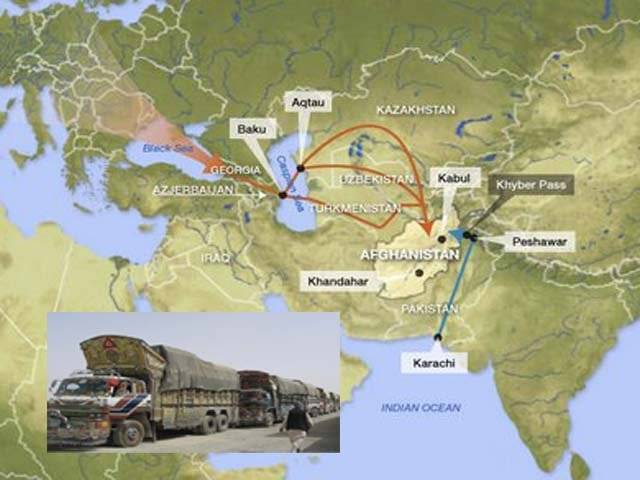WASHINGTON - The US military is rapidly expanding its Central Asian supply routes to the war in Afghanistan, fearing that Pakistan could cut off the main means of providing American and NATO forces with fuel, food and equipment, The Washington Post reported. Experts said U.S. officials prompt news media reports such as this one every time tensions erupt in the US-Pakistan relations. On Sunday, the post recalled that Pakistans temporary closure of a major crossing into Afghanistan in September, resulting in a logjam of hundreds of supply trucks and fuel tankers, dozens of which were destroyed in attacks by insurgents. "While reducing the shipment of cargo through Pakistan would address a strategic weakness that U.S. military officials have long considered an Achilles heel, shifting supply lines elsewhere would substantially increase the cost of the war and make the United States more dependent on authoritarian countries in Central Asia," the newspaper said. A senior U.S. defence official said the military wants to keep using Pakistan, which offers the most direct and the cheapest routes to Afghanistan. But the Pentagon also wants the ability to bypass the country if necessary. With landlocked Afghanistan lacking seaports, and hostile Iran blocking access from the west, it said Pentagon logisticians have limited alternatives. Its either Central Asia or Pakistan those are the two choices. Wed like to have both, the defence official said, "Wed like to have a balance between them, and not be dependent on either one, but always have the possibility of switching. U.S. military officials said they have emergency backup plans in case the Pakistan routes became unavailable. We will be on time, all the time, said Vice Admiral Mark Harnitchek, deputy commander of the U.S. Transportation Command, which oversees the movement of supplies and equipment. In such an event, however, the military would have to deliver the bulk of its cargo by air, a method that might not be sustainable; it costs up to 10 times as much as shipping via Pakistan, the Post said. Wed have to be a little bit more mindful of what we put in the pipe, Harnitchek said. Citing unnamed Pentagon officials, the Post said that in 2009, the United States moved 90 per cent of its military surface cargo through the Karachi port and then through mountain passes into Afghanistan. Now almost 40 per cent of surface cargo arrives in Afghanistan from the north, along a patchwork of Central Asian rail and road routes that the Pentagon calls the Northern Distribution Network, the newspaper said. The military is pushing to raise the northern network's share to as much as 75 per cent by the end of this year, the paper said. In addition, the US government is negotiating expanded agreements with Kazakhstan, Uzbekistan and other countries that would allow for delivery of additional supplies to the Afghan war zone, The Post said. The United States also wants permission to withdraw vehicles and other equipment from Afghanistan as the US military prepares to pull out one-third of its forces by September 2012, the paper noted. US President Barack Obama announced last month that 10,000 troops would leave this year and all 33,000 personnel sent as part of a surge ordered in late 2009 would be home by next summer, leaving a US force of some 65,000. There are currently up to 150,000 foreign troops in Afghanistan, including about 99,000 from the United States. Obama has indicated a series of drawdowns until Afghan forces assume security responsibility in 2014.
Friday, April 19, 2024
US military plans new supply lines into Afghanistan: Report

King Charles's cancer ‘eating him alive,' monarch unable to perform duties: Insider
1:02 AM | April 19, 2024
Mehwish Hayat says she would like to work with Aamir Khan
9:59 PM | April 18, 2024
What caused record-breaking rainfall in UAE?
9:58 PM | April 18, 2024
Donald Trump discusses Ukraine, Middle East, NATO with Polish President Duda
9:57 PM | April 18, 2024
'That'll be awesome,' Rohit Sharma on idea of Pakistan vs India Test series
9:17 PM | April 18, 2024
Hepatitis Challenge
April 18, 2024
IMF Predictions
April 18, 2024
Wheat War
April 18, 2024
Rail Revival
April 17, 2024
Addressing Climate Change
April 17, 2024
Justice denied
April 18, 2024
AI dilemmas unveiled
April 18, 2024
Tax tangle
April 18, 2024
Workforce inequality
April 17, 2024
New partnerships
April 17, 2024
ePaper - Nawaiwaqt
Advertisement
Nawaiwaqt Group | Copyright © 2024





